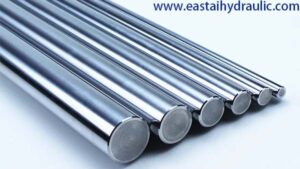Advanced Insights into Chrome Plated Shafts
Engineering, Applications, and Performance
As a manufacturer specializing in chrome plated shafts, we understand the critical role these components play in various industrial applications. Chrome plated shafts are renowned for their durability and resistance to wear and corrosion, making them a popular choice in machinery design. This article aims to provide a thorough understanding of chrome plated shafts, addressing common questions and comparing them with other materials such as stainless steel.

What is a Chrome Shaft?
A chrome shaft is a steel shaft that has undergone a process of electroplating with chromium. This process not only enhances the aesthetic appeal of the shaft but significantly improves its mechanical properties. The chrome layer adds hardness, reduces friction, and increases the shaft’s resistance to wear and corrosion. These qualities make chrome plated shafts ideal for use in high-stress environments where longevity and performance are paramount.
Is Chrome Plated Durable?
Chrome plated shafts are known for their enhanced durability. The chrome layer provides a hard, protective surface that withstands wear and tear better than many untreated materials. This makes them particularly suitable for applications where the shafts are exposed to constant friction or corrosive substances.
Advantages of Chrome Plated Shafts
Chrome plated shafts offer a combination of increased durability, wear and corrosion resistance, and reduced friction, making them ideal for demanding industrial applications. Their smooth, reflective surface not only enhances aesthetic appeal but also eases cleaning and maintenance. Additionally, their heat tolerance and versatility across various industries, from automotive to machinery, further elevate their utility and effectiveness.
Disadvantages of Chrome Plating
While chrome plating offers numerous advantages, it is not without its drawbacks. One significant disadvantage is environmental impact. The chrome plating process involves toxic chemicals, which, if not managed correctly, can be harmful to both the environment and the workers. Additionally, chrome plating can add complexity and cost to the manufacturing process.
Chrome Plated vs. Stainless Steel
When comparing chrome plated shafts to stainless steel, each has its unique advantages. Stainless steel is inherently corrosion-resistant and does not require additional plating, making it preferable in environments where plating might deteriorate. However, for applications requiring greater surface hardness and wear resistance, chrome plated shafts are superior.
Disadvantages of Chrome-Plated Steel
Aside from the environmental concerns, chrome-plated steel can have issues with plating adherence. If the plating process is not done correctly, the chrome layer can peel or chip, compromising the shaft’s integrity and resistance to corrosion and wear.
Can Chrome Plated Rust? Is Chrome Plating Rust Proof?
Chrome plating is highly resistant to rust, but it is not entirely rust-proof. If the chrome layer is damaged or wears thin, the underlying steel can become exposed to oxygen and moisture, leading to rust. Regular inspection and maintenance can mitigate this risk.
Should Chrome Plated Steel Shafts Be Used?
Chrome plated steel shafts are an excellent choice for applications requiring high strength, wear resistance, and corrosion resistance. While there are some disadvantages, such as environmental concerns and the potential for plating damage, the benefits often outweigh these issues. As a manufacturer of chrome plated shafts, we are committed to producing high-quality, durable products that meet the demanding needs of various industries.


